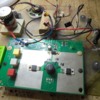We have Lionel 180 bricks powering our TIU. So, a friend brings over a Proto 1 engine to run, we switch the TIU from fixed too variable 1. Then we, turn the power on with the handheld to about 9-10 volts, engine starts up, we hit direction and the engine goes back to startup mode. We put the engine on our test stand, powered by a Z-4000, it starts up, move the voltage up to 9-10 volts, engine starts up hit direction engine goes into forward hit direction goes into neutral hit direction again goes in reverse and so on. So it works fine on the test stand and not on the layout. Could it be that we have the 180 bricks powering the layout, that the Proto 1 does not like?
I hope I'm explaining our problem well enough to help us.
Thanks for any help you can give.








